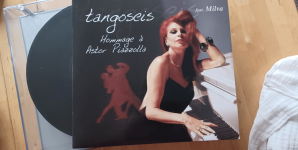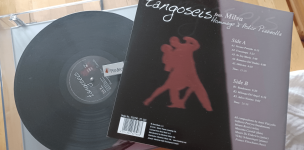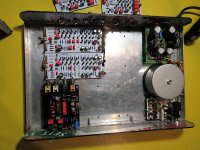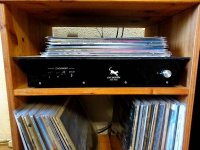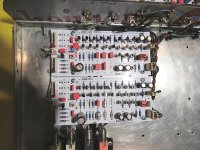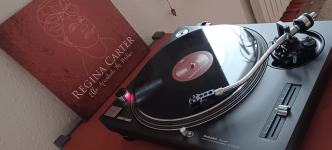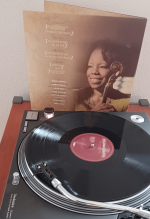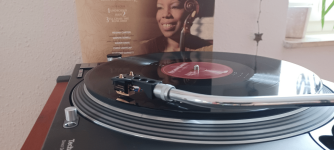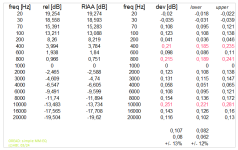I am always amazed at the fact that three different EQs (black box), which actually fulfill exactly the same task, can sound so different. It's these little nuances, like a kind of subtle taste - perhaps it would be more appropriate to call it character - that make it so fascinating and at the same time the search for a suitable partner (here in the sense of the signal reconstructing chain, of course).
I really like the unique character of the OREAD.

I really like the unique character of the OREAD.

A few rough data
With +/- 9V Rails I calculate an "overdrive reserve" (overload margin) of 19dB, based on a standard MM system with 5mVrms_max.
The very simple discrete operational amplifier of our core also works perfectly under different operating voltages.
Over the thumb, the quiescent currents vary from 643.2µA /2 to 1.371mA /2 in the input stage and 906.64µA /2 to 2.985mA /2 in the output stage.
The background noise seems to me to be subjectively louder at +/-6Vdc than at +/-12Vdc and the tiny little sparks I mentioned only appear in the right channel. I still have to get to the bottom of this phenomenon, but it doesn't bother me.
@catd
How many boards do you still have in stock? The circuit boards should be ripped out of your hands by now, right?
Do we need to emphasize once again that this is (naturally, but) operating class A?
With +/- 9V Rails I calculate an "overdrive reserve" (overload margin) of 19dB, based on a standard MM system with 5mVrms_max.
The very simple discrete operational amplifier of our core also works perfectly under different operating voltages.
Over the thumb, the quiescent currents vary from 643.2µA /2 to 1.371mA /2 in the input stage and 906.64µA /2 to 2.985mA /2 in the output stage.
The background noise seems to me to be subjectively louder at +/-6Vdc than at +/-12Vdc and the tiny little sparks I mentioned only appear in the right channel. I still have to get to the bottom of this phenomenon, but it doesn't bother me.
@catd
How many boards do you still have in stock? The circuit boards should be ripped out of your hands by now, right?
Do we need to emphasize once again that this is (naturally, but) operating class A?
Pure enthusiasm, it literally draws me into the recording - you absolutely must have heard the 1963 recording of the legendary album GETZ / GILBERTO or Sting's 1987 "nothing like the sun". It doesn't matter, even Adele doesn't distort. From Mozart to Gianna Nannini ... OREAD can do everything, he inspires in every genre. Even the smallest AT-MM is addictive.
I'm looking forward to hearing other listeners' descriptions, but first you have to set up / build the little equalizer too 😉 .
I'm looking forward to hearing other listeners' descriptions, but first you have to set up / build the little equalizer too 😉 .
Both of my boards are now finished, installed and tested.
What's particularly noticeable is the OREAD's extremely low noise level, which you only notice when the volume control is almost all the way up. The OREAD is a little quieter than the SUPRA, which I have ready to use for direct comparison. I would not have expected this.
I would like to say the following about the sound of the OREAD: It doesn't have one.🙂
I am of the opinion that a good amplifier has no sound, but simply outputs what comes in at the front amplified at the back. I think the OREAD delivers 100% in this regard
Attached is my current circuit.
Even without a housing or additional capacitor, no oscillations can be detected.
The boards are built into a case, along with my CX-expander, which needs to be connected between a RIAA-EQ output and a pre-amp input. This CX-expander has a relatively low input impedance of just over 10 kΩ. As discussed in a post above, loading the OREAD output with such a low impedance will cause the RIAA curve to bend a bit. I therefore slightly adjusted the values of the RIAA network for the low-impedance output termination. But this is actually just high-end cosmetics. I spent - unnecessarily - a fair amount of time picking out from a stack of components those that deliver exactly the values shown.
because of other PCBs:
Three pairs are still available.
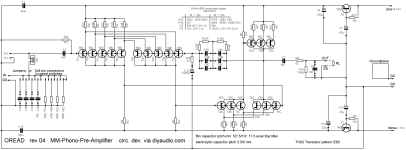
What's particularly noticeable is the OREAD's extremely low noise level, which you only notice when the volume control is almost all the way up. The OREAD is a little quieter than the SUPRA, which I have ready to use for direct comparison. I would not have expected this.
I would like to say the following about the sound of the OREAD: It doesn't have one.🙂
I am of the opinion that a good amplifier has no sound, but simply outputs what comes in at the front amplified at the back. I think the OREAD delivers 100% in this regard
Attached is my current circuit.
Even without a housing or additional capacitor, no oscillations can be detected.
The boards are built into a case, along with my CX-expander, which needs to be connected between a RIAA-EQ output and a pre-amp input. This CX-expander has a relatively low input impedance of just over 10 kΩ. As discussed in a post above, loading the OREAD output with such a low impedance will cause the RIAA curve to bend a bit. I therefore slightly adjusted the values of the RIAA network for the low-impedance output termination. But this is actually just high-end cosmetics. I spent - unnecessarily - a fair amount of time picking out from a stack of components those that deliver exactly the values shown.
because of other PCBs:
Three pairs are still available.

Last edited:
My daily hearing tests
Paul Simon's 1986 album Graceland - here, too, the equalizer really packs a punch, with an incredible attack (but something is missing for me, namely the fine detail and some atmosphere above it - but that can only be attributed to the AT VM95C system, not the equalizer) and dynamics.
The weaknesses of the cheapest (still usable) MM in the world are also revealed on Simply Red's legendary debut album Picture Book, it is not an MC and will never become one, completely independent of any equalizer design.
A beginner's system cannot reproduce infinity with minimal travel. But with our EQ, even the AT VM95C puts any streaming service in the shade.
If you have ever been captured by the tango, live and in color of course, I recommend a current pressing - and especially the bandoneon, with OREAD it breathes and creaks, just as it should.
But you'll want more of this stuff soon, so be careful.
kind regards,
HBt.
Paul Simon's 1986 album Graceland - here, too, the equalizer really packs a punch, with an incredible attack (but something is missing for me, namely the fine detail and some atmosphere above it - but that can only be attributed to the AT VM95C system, not the equalizer) and dynamics.
The weaknesses of the cheapest (still usable) MM in the world are also revealed on Simply Red's legendary debut album Picture Book, it is not an MC and will never become one, completely independent of any equalizer design.
A beginner's system cannot reproduce infinity with minimal travel. But with our EQ, even the AT VM95C puts any streaming service in the shade.
If you have ever been captured by the tango, live and in color of course, I recommend a current pressing - and especially the bandoneon, with OREAD it breathes and creaks, just as it should.
But you'll want more of this stuff soon, so be careful.
kind regards,
HBt.
Attachments
FantasticBoth of my boards are now finished, installed and tested.
and very quickly put the idea into practice.
What's particularly noticeable is the OREAD's extremely low noise level, which you only notice when the volume control is almost all the way up. The OREAD is a little quieter than the SUPRA, which I have ready to use for direct comparison. I would not have expected this.
Theoretically, this result was clear from the outset.
But what probably fascinates us again and again is the symmetry of the SUPRA between its two supply voltages, but this is not necessarily better, it is just different.
I would like to say the following about the sound of the OREAD: It doesn't have one.🙂
I am of the opinion that a good amplifier has no sound, but simply outputs what comes in at the front amplified at the back. I think the OREAD delivers 100% in this regard
Absolutely correct, the black box has only one technical task to fulfill.
Attached is my current circuit.
Even without a housing or additional capacitor, no oscillations can be detected.
That's great,
all oscillations can already occur simply due to the probe used or other wiring gizmos - so I'm not particularly surprised by the result, a shorter or thicker cable here or there, fed back to any potential ... and the oscillation is gone.
The boards are built into a case, along with my CX-expander, which needs to be connected between a RIAA-EQ output and a pre-amp input. This CX-expander has a relatively low input impedance of just over 10 kΩ. As discussed in a post above, loading the OREAD output with such a low impedance will cause the RIAA curve to bend a bit. I therefore slightly adjusted the values of the RIAA network for the low-impedance output termination.
You clearly show here how you have already penetrated the field of "audio electronics", especially small signal amplifiers - even though this field is only a hobby of yours, but nothing is too difficult for a real engineer.
It is also remarkable (in this day and age) that you have responded to the call to find your own dimensions.
But this is actually just high-end cosmetics. I spent - unnecessarily - a fair amount of time picking out from a stack of components those that deliver exactly the values shown.
Nevertheless:
Respect!
An "impedance converter" solves the inherent problem.
Thanks again
and I wish you much joy with your new (member of the ensemble) equalizer.
HBt.
Finally,
I will carry out a few more measurements in the next few days and submit the results - and then that's enough.
With the frequency-dependent input resistance, I urge caution with automated measurements/methods of this complex resistance, here we usually overdrive the small amplifier and I fear this has also happened to me.
I am almost 100% sure that my suspicions in this regard will be confirmed. Already two different systems and their internal conversion methods, level, current ... also result in significantly different values.
My guess here is correct 47kOhm in parallel >100pF. But I'll get to the bottom of this correctly, until then R11 remains 220kOhm (330kOhm doesn't hurt and vice versa).
Basically, we can completely rely on the simulation results, the models used will also be correct / fit as far as possible.
Until then, I hope you continue to enjoy your music with our equalizer project.
Suggestions, opinions, cooperation, replicas, own creations ... are extremely welcome and desired.
Greetings,
HBt.
I will carry out a few more measurements in the next few days and submit the results - and then that's enough.
With the frequency-dependent input resistance, I urge caution with automated measurements/methods of this complex resistance, here we usually overdrive the small amplifier and I fear this has also happened to me.
I am almost 100% sure that my suspicions in this regard will be confirmed. Already two different systems and their internal conversion methods, level, current ... also result in significantly different values.
My guess here is correct 47kOhm in parallel >100pF. But I'll get to the bottom of this correctly, until then R11 remains 220kOhm (330kOhm doesn't hurt and vice versa).
Basically, we can completely rely on the simulation results, the models used will also be correct / fit as far as possible.
Until then, I hope you continue to enjoy your music with our equalizer project.
Suggestions, opinions, cooperation, replicas, own creations ... are extremely welcome and desired.
Greetings,
HBt.
Very nice to see the progress, this made me restart KiCad and change the layout a bit, it is more compact now and i put some of the resistors at the back side of the board, since this will be hand soldered and not mass produced it is no real downside. I looked in my stash and i have about 120 each of NXP BC850C and BC860C so I have all the transistors already. There is LM7815/7915 in sot89 followed by capacitance multiplier with BCX53/56 for some cleanup like the original SUPRA.


The input impedance
is 47kOhm in parallel 76pF with more than sufficient accuracy (and I worked very carefully this time).
The most practicable method for me in the home sector seems to be the voltage divider method already described. I have tried several methods, including an improvised vector voltmeter, but even this determination is not entirely trivial.
My tip remains the same: trust the simulation results!
47k || 76pF
is 47kOhm in parallel 76pF with more than sufficient accuracy (and I worked very carefully this time).
The most practicable method for me in the home sector seems to be the voltage divider method already described. I have tried several methods, including an improvised vector voltmeter, but even this determination is not entirely trivial.
My tip remains the same: trust the simulation results!
47k || 76pF
Determination of input capacitance
I simply assume the input of the amplifier/OREAD as a capacitor of unknown value.
I connect this capacitor in series with a known inductor and thus obtain a resonant circuit.
If I do a frequency sweep on it, I get a maximum at a certain frequency from which I can calculate the value of the capacitor.
I do the whole thing with the LTSpice simulation.
(Here I don't even have to do the math myself. At the same time, I create a second resonant circuit with the same inductance and adjust the capacitor value so that the two resonant maxima are together.)
This gives me an input capacitance of the OREAD of around 27pF.
That's slightly less than your result.
? Now what is right?

And here is the simulation of the input resistance

I simply assume the input of the amplifier/OREAD as a capacitor of unknown value.
I connect this capacitor in series with a known inductor and thus obtain a resonant circuit.
If I do a frequency sweep on it, I get a maximum at a certain frequency from which I can calculate the value of the capacitor.
I do the whole thing with the LTSpice simulation.
(Here I don't even have to do the math myself. At the same time, I create a second resonant circuit with the same inductance and adjust the capacitor value so that the two resonant maxima are together.)
This gives me an input capacitance of the OREAD of around 27pF.
That's slightly less than your result.
? Now what is right?
And here is the simulation of the input resistance
Last edited:
Good question "catd" - what value did I take from the simulation? Later!
For the time being, I recorded it absolutely with household means, i.e. the way you would show it to a young student as an exercise in using an analog oscilloscope.
Calculating with the deflection coefficients ...

I think the trend is very easy to recognize - even the three very obvious reading errors can be detected immediately. This is the course of my current left channel, randomly - random samples.
This test shows how well OREAD follows the standard approximation - and you can prove all this with a simple sine wave generator and a scope.
Means used:
DDS function generator S-LS-44 Steinberg
Hameg HM407
Calculator TI-30
Input voltage constant 20mVpp
The method and the entire procedure should be familiar. G_1kHz = 38.89dB (determined by measurement), which corresponds to a factor of 85.
For the time being, I recorded it absolutely with household means, i.e. the way you would show it to a young student as an exercise in using an analog oscilloscope.
Calculating with the deflection coefficients ...
I think the trend is very easy to recognize - even the three very obvious reading errors can be detected immediately. This is the course of my current left channel, randomly - random samples.
This test shows how well OREAD follows the standard approximation - and you can prove all this with a simple sine wave generator and a scope.
Means used:
DDS function generator S-LS-44 Steinberg
Hameg HM407
Calculator TI-30
Input voltage constant 20mVpp
The method and the entire procedure should be familiar. G_1kHz = 38.89dB (determined by measurement), which corresponds to a factor of 85.
If it is OK, I will refrain from further determination with other measuring equipment / analyzers. I deliberately chose the old school method, completely analog ...
Your 27pF is almost certainly too low.
<100pF but >11pf (that was my extrapolated simulation result) is plausible.
The only error, or inaccuracy, is in the reading process - you know the number with the deflection coefficients of the HAMEG or any other old scope. So I proceeded very carefully and trust my results.
47kOhm || 76pf over the entire audioband with very, very little deviations is correct - in real life situation / my DUT.
Your 27pF is almost certainly too low.
<100pF but >11pf (that was my extrapolated simulation result) is plausible.
The only error, or inaccuracy, is in the reading process - you know the number with the deflection coefficients of the HAMEG or any other old scope. So I proceeded very carefully and trust my results.
47kOhm || 76pf over the entire audioband with very, very little deviations is correct - in real life situation / my DUT.
OK, my simulation doesn't take into account the PCB's capacitances. I tried to simulate this by adding LTSpice .option cshunt=xxx which adds the named capacitance between each node and ground. To get your input capacitance of 75pF I had to specify cshunt = 9.5pF.
Then the difference between our results of around 50 pF is probably due to the board. Maybe not even that much for the relatively large thing.
Then the difference between our results of around 50 pF is probably due to the board. Maybe not even that much for the relatively large thing.
Between the tracks there is a copper area at the top and bottom (and that's a good thing), I have bridged these areas "GC" with "GS", while the entire housing has 100Ohm||100nF ---> 50Ohm||200nF ---> to the GND of the PSU via the front and rear plates respectively.
But my God, if Cx = Cp is now geometrically 45.3pF as the true value, then everything is great.
No more worrying,
just enjoy the music.
But my God, if Cx = Cp is now geometrically 45.3pF as the true value, then everything is great.
No more worrying,
just enjoy the music.
Attachments
Maybe we'll soon develop an EQ for real systems - but that's for the future.
Tip:
Regina Carter
Ella: Accentuate the Positive
OKEH Records
Tip:
Regina Carter
Ella: Accentuate the Positive
OKEH Records
Attachments
I don't understand. Isn't Oread a real riia-eq/pre for a real turntable stereo system?Maybe we'll soon develop an EQ for real systems - but that's for the future
Cheers!
of course it is
🙂
I think a 'real system' here means, somewhat facetiously, an MC, e.g. the OC9 in the shown pic.
I don't like the concept of an overpriced disposable cartridge.
In principle it is exactly that, as it is often better to buy a new MC cartridge for little more than the price of a retipping and then have a fresh needle suspension again.
I once bought a new Ortofon MC20, which was quite good, until after a few years the needle carrier simply fell out, so I could only throw it away.
There are also good MM systems and I no longer have this great enthusiasm for vinyl to spend so much money on MC.
Is there actually any MC system with a user-replaceable needle?
🙂
I think a 'real system' here means, somewhat facetiously, an MC, e.g. the OC9 in the shown pic.
I don't like the concept of an overpriced disposable cartridge.
In principle it is exactly that, as it is often better to buy a new MC cartridge for little more than the price of a retipping and then have a fresh needle suspension again.
I once bought a new Ortofon MC20, which was quite good, until after a few years the needle carrier simply fell out, so I could only throw it away.
There are also good MM systems and I no longer have this great enthusiasm for vinyl to spend so much money on MC.
Is there actually any MC system with a user-replaceable needle?
Last edited:
- Home
- Source & Line
- Analogue Source
- Oread - a DIY MM phono approach
